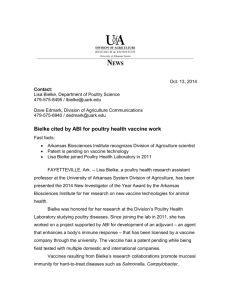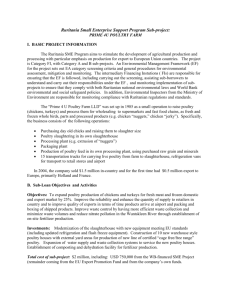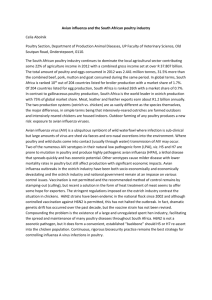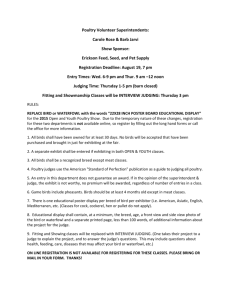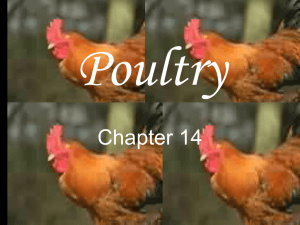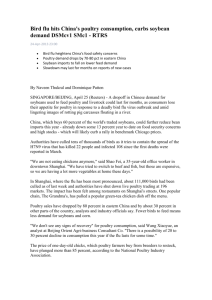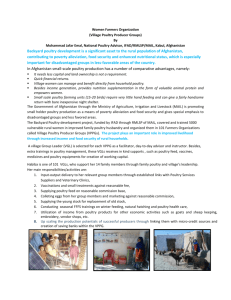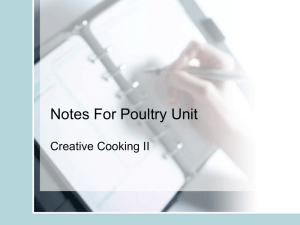15poultexam
advertisement
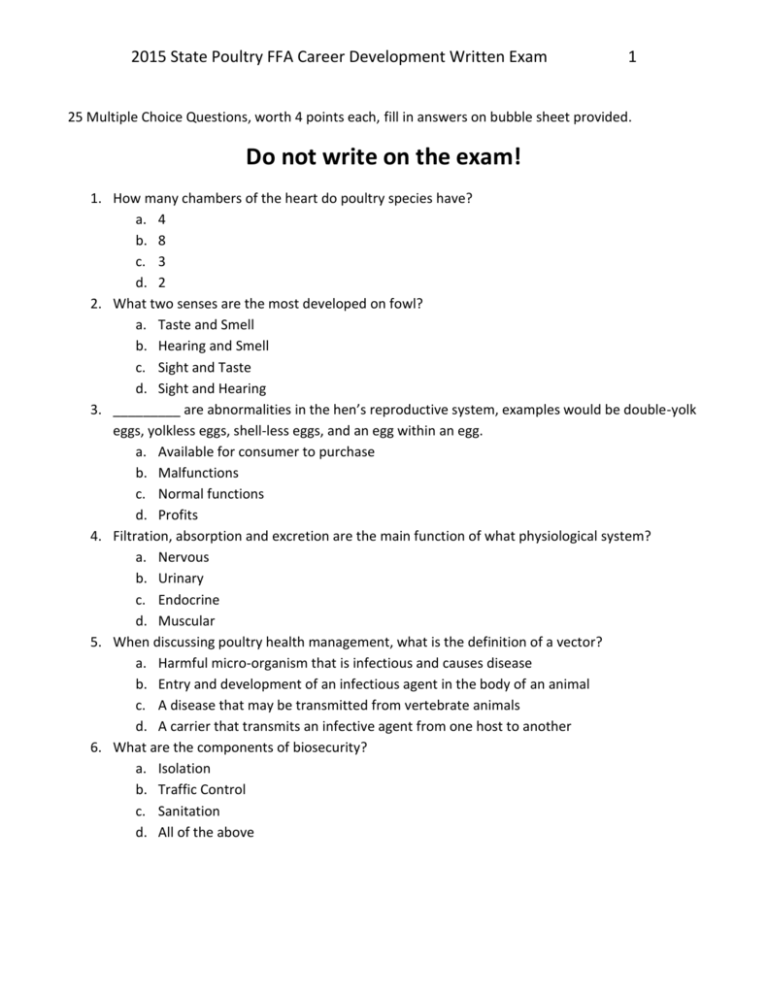
2015 State Poultry FFA Career Development Written Exam 1 25 Multiple Choice Questions, worth 4 points each, fill in answers on bubble sheet provided. Do not write on the exam! 1. How many chambers of the heart do poultry species have? a. 4 b. 8 c. 3 d. 2 2. What two senses are the most developed on fowl? a. Taste and Smell b. Hearing and Smell c. Sight and Taste d. Sight and Hearing 3. _________ are abnormalities in the hen’s reproductive system, examples would be double-yolk eggs, yolkless eggs, shell-less eggs, and an egg within an egg. a. Available for consumer to purchase b. Malfunctions c. Normal functions d. Profits 4. Filtration, absorption and excretion are the main function of what physiological system? a. Nervous b. Urinary c. Endocrine d. Muscular 5. When discussing poultry health management, what is the definition of a vector? a. Harmful micro-organism that is infectious and causes disease b. Entry and development of an infectious agent in the body of an animal c. A disease that may be transmitted from vertebrate animals d. A carrier that transmits an infective agent from one host to another 6. What are the components of biosecurity? a. Isolation b. Traffic Control c. Sanitation d. All of the above 2015 State Poultry FFA Career Development Written Exam 7. Where should newly hatched chicks be vaccinated for Marek’s disease? a. Broiler House b. Through the feed c. At the hatchery d. They do not need to be vaccinated 8. What is the average body temperature of poultry? a. 105oF – 107oF b. 98.6oF c. 100oF – 101oF d. 112oF 9. What is Psychrometry? a. The study of light spectrum b. The study of turkey’s interaction with each other c. The study of digestion d. The study of moist air and the changes in its conditions 10. Leghorn strain hens will lay approximately how many eggs per year? a. 365 b. 265 c. 180 d. 300 11. What are the top two chicken meat products in the United States? a. Boneless/Skinless Breast Fillet and the chicken tender b. Boneless Thigh and Chicken tender c. Drumstick and Skinless Thigh d. Wing and Boneless/Skinless Breast Fillet 12. What does the term “dubbing” mean? a. Removal of the feathers b. Cutting the flight feathers so the bird cannot fly c. Surgical removal of the comb and wattles d. Pinioning the wing so the bird cannot fly 13. What does the acronym HPAI stand for? a. Healthy Pheasant Association Informants b. Health and Production of Avian Influenza c. High Path Avian Influenza d. Hawaiian Poultry Association Institute 2 2015 State Poultry FFA Career Development Written Exam 3 14. What percentage of chickens are sold in the United States as whole birds? a. 50 % b. 20% c. Less than 10% d. 33% 15. What are the top two countries the United States export poultry meat to? a. Ireland and Germany b. Mexico and Canada c. Japan and China d. Russia and China 16. What organ is green in color, attaches to the liver, and stores bile? a. Cecum b. Gall Bladder c. Trachea d. Crop 17. The gizzard serves as the bird’s _________. a. Teeth b. Lungs c. Liver d. Hormonal Gland 18. Where does fertilization occur in the reproductive tract? a. Magnum b. Uterus c. Isthmus d. Infundibulum 19. Phenols, Quaternary ammonium compounds, iodophors, hypochlorites are examples of what? a. Poultry Diseases in Pheasants b. Turkey Industry Vaccines c. Waterfowl Antibiotics d. Disinfectant classes 20. How many air sacs do birds have as part of their respiratory system? a. 2-3 b. 12 c. 8-9 d. 4 2015 State Poultry FFA Career Development Written Exam 4 21. If cooling water consumption is one gallon per minute per 100 square feet of pad area on a hot day. How many gallons of water per minute will a be consumed in a pad that measures 3600 square feet? a. 3.6 gallons b. 36 gallons c. 100 gallons d. 3,600 gallons 22. What is the pulse rate of a bird at rest? a. 223 beats per minute b. 300 beats per minute c. 60 beats per minute d. 180 beats per minute 23. What is another name for laying an egg? a. Oviposition b. Fertilization c. Blastoderm d. Blastodisc 24. What are the disease prevention and control measures that can occur to keep flocks healthy? a. Reduce contact between birds and infectious organisms b. Maintaining sanitary conditions c. Strengthening the bird’s defenses again invasion by infectious organisms d. All of the above 25. A flock of 25,000 birds contract Newcastle disease. The birds are weak, have watery greenish diarrhea, a cough, gasping respiration, nasal and eye discharge. The mortality has spiked 10%. What is the current flock size? a. 22,500 b. 2,500 c. 12,500 d. 250 2015 State Poultry FFA Career Development Written Exam 2015 State FFA Poultry Career Development Answer Key 1. A 2. D 3. B 4. B 5. D 6. D 7. C 8. A 9. D 10. B 11. A 12. C 13. C 14. C 15. D 16. B 17. A 18. D 19. D 20. C 21. B 22. B 23. A 24. D 25. A C-13 C-19 C-23 C-25 C-39 C-43 C-47 C-13 C-75 C-113 C-114 C-116 C-51 C-116 C-118 C-23 C-22 C-24 C-55 C-20 C-85 C-13 C-24 C-54 C-47 5

